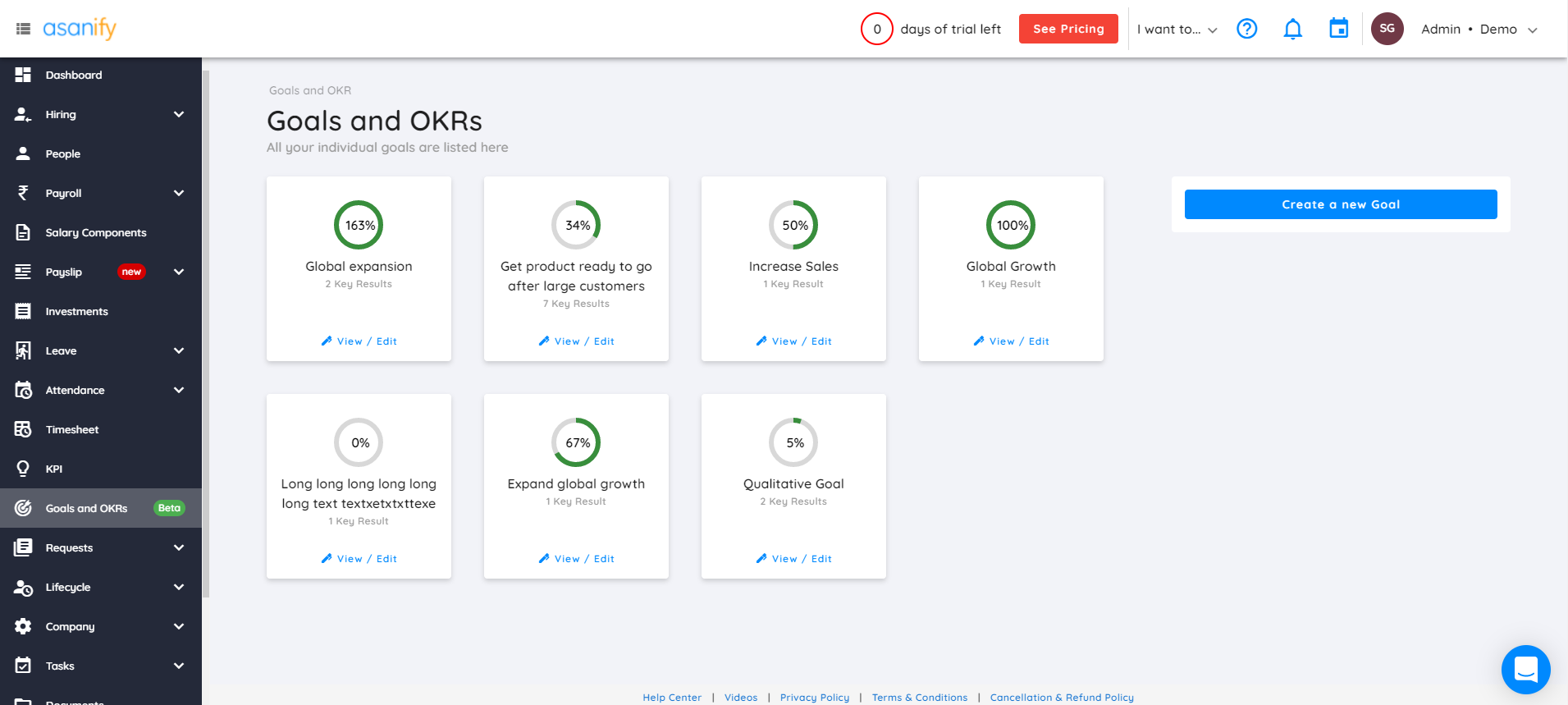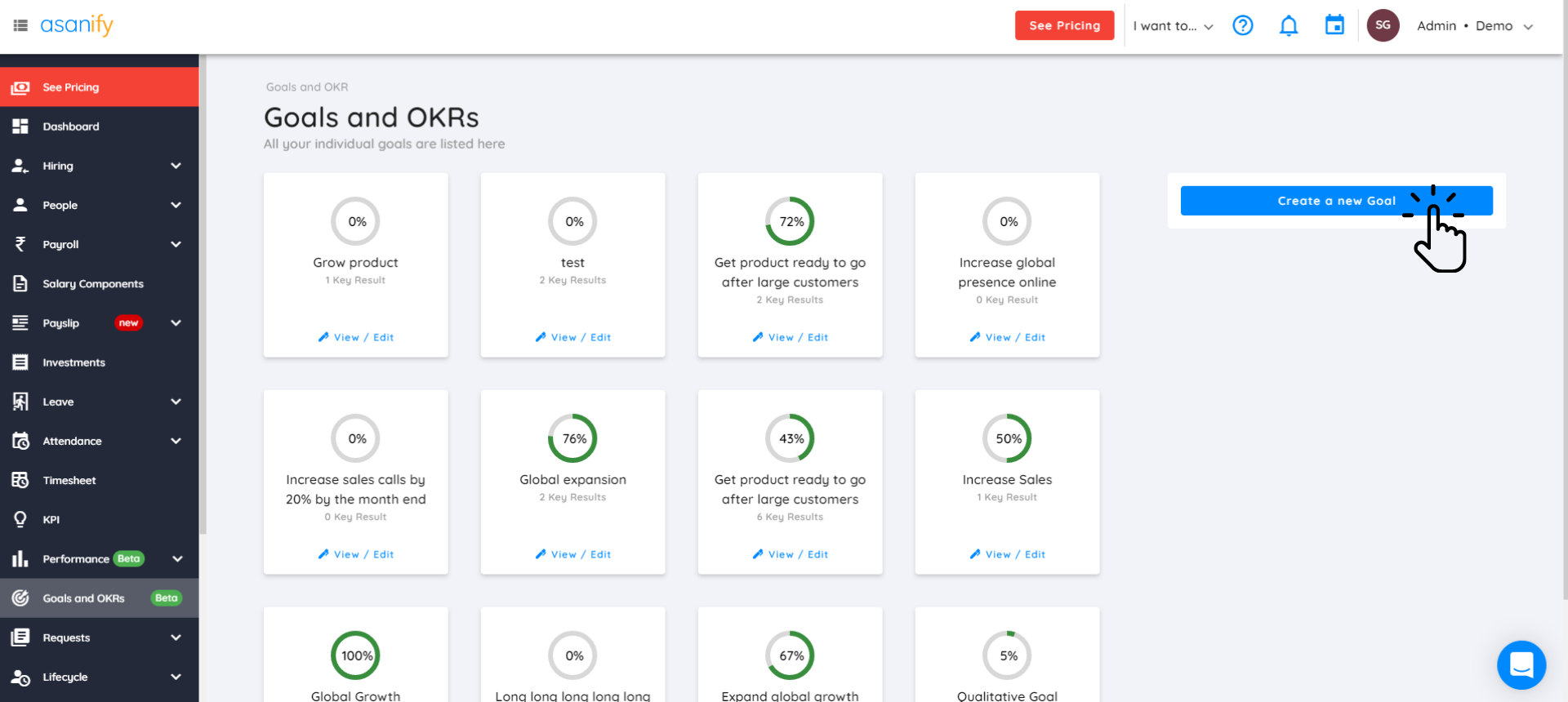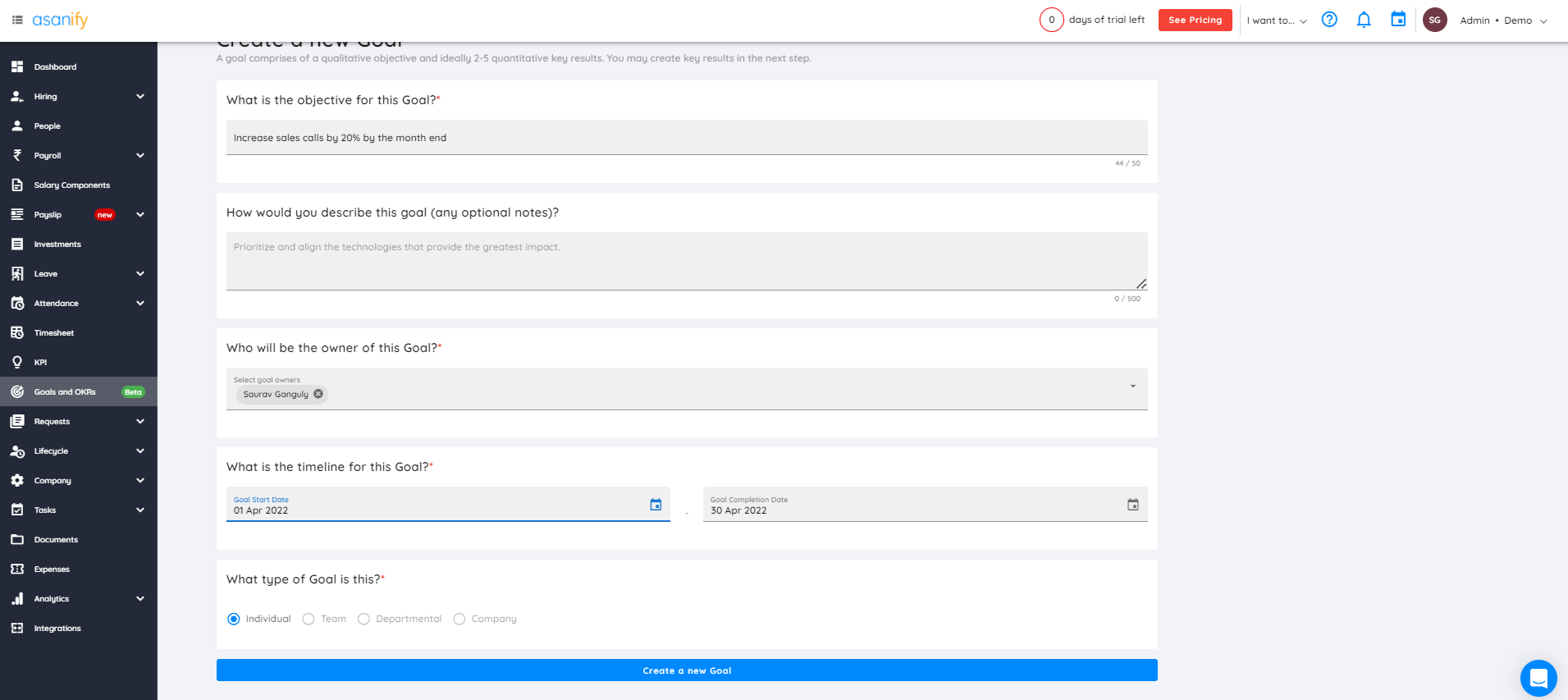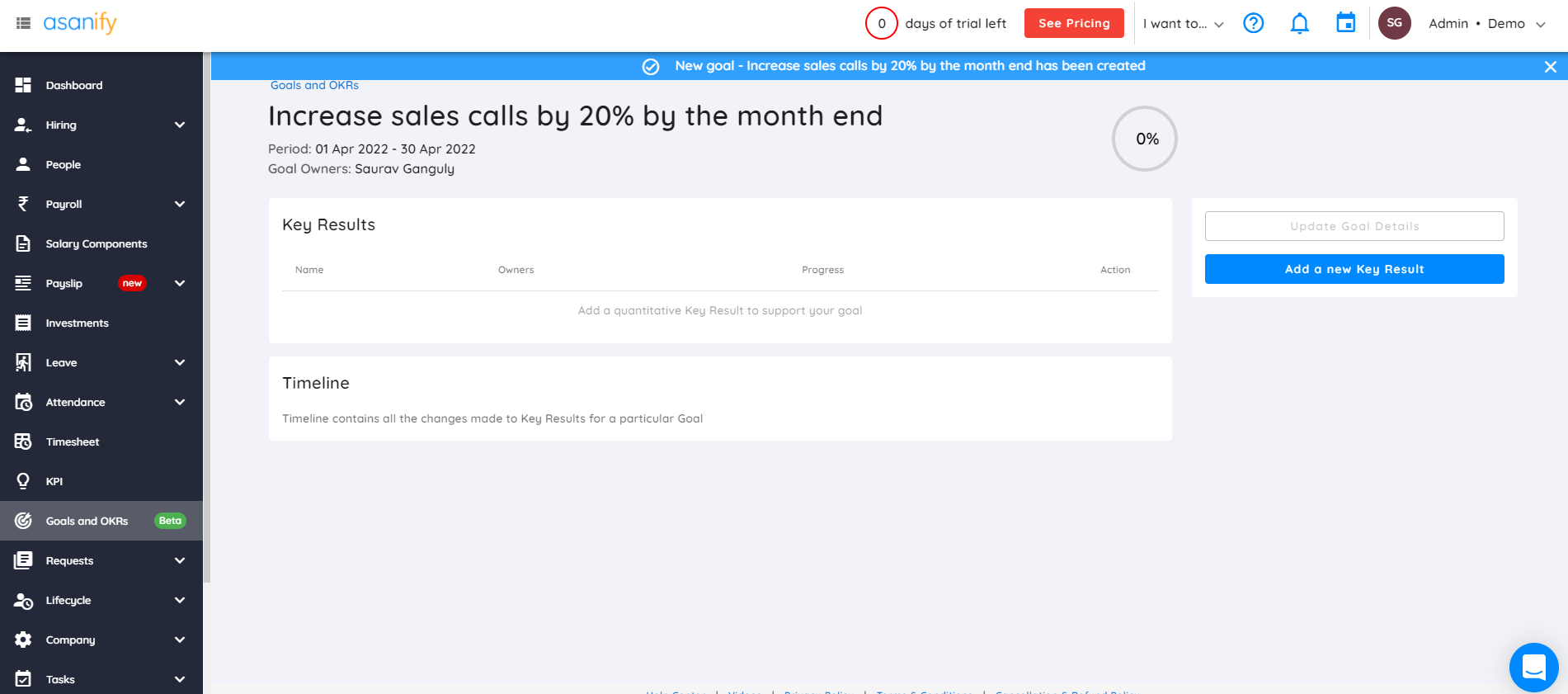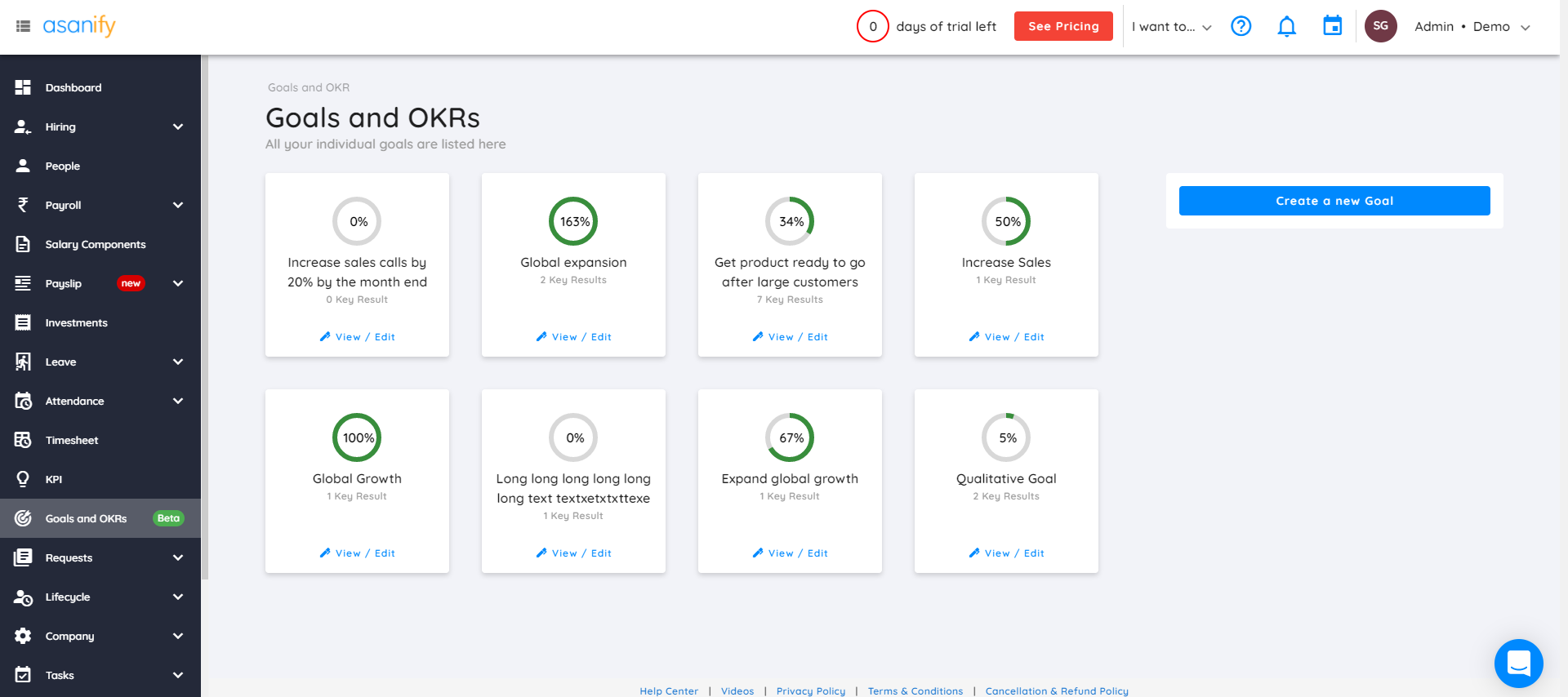Goal setting is the process of deciding what you want to accomplish and devising a plan to achieve those desired results. For entrepreneurs, goal setting is an important part of business planning. For effective goal setting, you need to do more than just decide what you want to do.
You also have to work towards accomplishing whatever goal you have set. For many people, it’s the second part of the goal-setting definition that’s a problem. They know what they want to do and they’re perfectly willing to work on it, but they have trouble creating a plan to get there.
- What is goal setting?
- Why is goal setting important?
- Types of goal setting
- How does goal setting improve performance?
- Key principles of setting goals
- 5 components of goal setting
- How can you set goals in 7 steps?
- How to create SMART goals on Asanify
- Setting goals for business success
- How to achieve your goals consistently?
- Measure your goals
- Summary – Start setting your goals
- FAQs
What is goal setting?
Some people may struggle to stick to their goals because they don’t differentiate them from more casual, everyday self-improvement attempts. Just because you decide to run every day doesn’t mean you’ve set a deliberate goal for yourself. So, let’s have a look at what goal setting actually means.
Goal setting is a deliberate and clear process that begins with the identification of a new goal, skill, or project that you wish to accomplish. Then you devise a strategy for attaining this goal and work to see it through.
Instead of simply running for the sake of running, a true aim would be to begin a training programme in order to complete a specified race, such as a marathon, which involves much more precise planning, motivation, and discipline.
Also Read: How Balanced Scorecard [BSC] can unlock peak performance for you
History of goal setting
Goal setting theory was first formulated by Edwin A. Locke in the 1960s, when he published his first article on the subject “Toward a Theory of Task Motivation and Incentives”, in 1968. He derived the idea of goal setting from Aristotle’s form of final causality. Aristotle stated that purpose can cause action. Thus, Locke began to study the impact of goals on human activity.
The main ideas of this theory were:
- Difficult and more specific goals lead to higher performance as compared to easy goals
- The higher the goal, the higher was the performance
- The influence on the behaviour of variables such as praise, feedback and involvement of people in decision making of goals was the setting of and subsequent commitment to a specific difficult goal.
- Factors such as praise, feedback, and/or involvement in the decision making and setting of the goals played a big role in the person’s commitment toward the said goal.
What is the goal setting theory?
Goal setting is an employee engagement strategy that involves setting specific and measurable goals that can in turn improve employee productivity. It is one of the best ways to improve both employee performance and engagement at the same time.
Edwin A. Locke wrote about this in his article, “Toward a Theory of Task Motivation and Incentive.” in 1968. It showed how employees were motivated by well-defined goals and constructive feedback. It also spoke about how employees are more likely to achieve these goals when they are specific and measurable.
Locke also emphasized when employees face challenging goals, they perform well. Since these difficult goals push employees to develop their skills, it results in an overall positive feeling. This leads to higher productivity, engagement and satisfaction at the workplace.
What are the three types of goals?
Process, performance, and outcome goals are the three types of goals. Specific actions or ‘processes’ of executing are called process goals.
Suppose you set a goal to study for two hours after supper every day. Individuals have complete control over the process goals. Personal standards are used to set performance goals.
For instance, aiming for a 3.5 GPA. Personal objectives are mostly within one’s control. Winning is the basis for outcome goals.
For a college student, this can mean finding a job in his/her field or at a company where he/she has always wanted to work. Because of external factors, outcome goals can be extremely difficult to regulate.
Why is goal setting important?
In goal setting, there is plenty of research, particularly in the organizational context. Initially, the goal of this investigation was to determine how the expected level of achievement (the goal) relates to the actual level of achievement (performance) in an organizational setting.
There is evidence that defining goals increases employee motivation and organizational commitment. Goals also influence the intensity of our actions and emotions: the more difficult and valuable a goal is, the more intense our efforts to get it will be, and the more success we will experience thereafter. This is obviously assuming the goal set isn’t too high and hence beyond the reach of the employee!
There is a lot of research on goal setting, especially in organizational settings. The initial purpose of this study was to see how the expected level of achievement of the goal compares to the actual level of performance in an organization. Our ability to plan has a beneficial influence on our perception of control over goal outcomes and our future. Goal-setting and achievement can also help people create an internal centre of control.
Individuals with an external locus of control feel that external forces handle both positive and negative outcomes, whereas those with an internal locus of control believe their own actions and abilities decide their success.
You could also take a look at our blog on “OKR The Ultimate Guide: Learn how to create goals for your team”
Why should you set goals?
You can evaluate and take joy in achieving your goals by creating precise, clearly defined targets. You will hence, see positive progress in what may have previously looked like a long, fruitless grind. As you realise your own skill and competency in attaining the goals you’ve set, you’ll gain self-confidence.
Benefits of goal setting in your organization
There are many benefits of goal setting:
- Setting clear goals provides a direction of where you want to be as an organization
- It ensures that employees work towards a shared vision.
- Improves motivation of employees to achieve both short-term and long-term objectives
- It helps in developing a sense of accountability in employees.
- Provides a clear understanding of what is necessary and what is not.
- It helps you avoid activities that are not relevant to achieving your goal, thus saving you valuable time.
- Setting goals helps you stay in control of the future.
- Setting goals can help you measure success better.
What are the types of goal setting?
Setting clear goals and understanding the type of goal you want to achieve is the first step toward achieving your objectives. Goal setting involves planning with targets for individuals and teams. Some common types of goal setting are:
- Mission statement – A short and inspiring statement incorporating your company’s goals, principles and values.
- Vision statement – It is a short, inspiring and catchy statement that encompasses all goals, focusing on the future of your organization.
- Audacious goals – Overly ambitious goals that you are not likely to achieve but this statement is used to motivate employees and inspire your customers

- S.M.A.R.T. – Commonly used in goal setting, SMART goals are always a great choice. This is because the abbreviation itself reminds you of the different aspects you need to cover while setting goals for your team! S.M.A.R.T. talks about a single goal being all of the following – Specific, Measurable, Achievable, Relevant and Time-bound.
- Management by objectives – Management by objectives is a management technique that implements strategies and manages performance with a process of participative goal setting.
- Balanced scorecard – The Balanced Scorecard essentially calls for organizations to create a set of internal metrics that will help them to assess their business performance in 4 key areas, namely: finance, customer, internal and learning.
How does goal setting improve performance?
Studies by Edwin A. Locke and his colleagues, most notably Gary Latham, have shown that more specific and ambitious goals lead to more performance improvement than easy or general goals. Individual performance is impacted.
Managers cannot maintain consistent motivation or keep track of an employee’s job. Goals are thus a useful tool for managers since they can serve as a self-regulatory mechanism that helps staff prioritize activities.
Work-life balance
Some businesses utilize goal-setting to ensure that employees maintain a healthy work-life balance. Employees establish a non-work-related objective to improve their well-being, and supervisors assist team members in sticking to their goals. “One Simple Thing,” a goal-setting well-being technique used by Google, is an example of this in action.
Key principles of setting goals
According to the goal-setting theory of Locke, goals that you set should include the following
- Clarity – When there are clear goals, employees understand what they want to achieve. There is less risk of misunderstanding. You can measure the results accurately and reward them accordingly.
- Challenge – Goals should be challenging enough to motivate an employee. They should keep employees engaged and focused on work, but keep in mind that these goals should not be so challenging that they can’t be achieved.
- Commitment – Your team should understand and support the goals clearly that they have been assigned. They will be more likely to enjoy the process and ultimately achieve the goal that they are committed to.
- Feedback – It is an important part of goal setting theory because you can measure the progress of your team and how they are doing. It gives you the opportunity to adjust the difficulty of the goal, expectations from people and overall progress of the goal.
- Task complexity – ensure the work doesn’t become too overwhelming when a complex task or goal is assigned. If a goal is too big and complex, it should be broken down into smaller goals.
What are the 5 components of setting goals?
Set Specific Objectives
Your objectives must be specific in order to motivate you. It’s beneficial to jot down as much information as possible when thinking about the things you wish to do. Adding specifics to your objective makes it more tangible in your mind and pushes you to achieve it.
Measurable Objectives
Giving yourself a measurable path might help you stay motivated with both long and short-term goals. By setting a measurable objective, you can track your progress and determine when the goal is complete.
Acquire it
Setting objectives can help you gain confidence and hence, develop as a person. As you achieve each of your objectives, it will inspire you to set new objectives. One of the most important aspects of goal-setting is ensuring that your objectives are attainable within the time limit you establish.
Recognize what is realistic.
There is a huge difference between setting goals that are challenging versus goals that are unrealistic and unachievable! The goals you set for yourself may appear unattainable, but if you can devise a step by step path to achieve them, they may not be so difficult to reach after all.
Establish a Timeline.
Allowing your goals to remain open-ended allows you to delay and procrastinate. Give yourself a deadline for completing your goals when you set them. Setting a time period allows you to distinguish between short-term and long-term objectives.
Goal setting in 7 steps?
A goal-setting process pushes you to consider the route (i.e., how you’ll achieve your objectives) rather than just the final destination. To get started, follow the steps listed below.
-
Consider the outcomes you desire.
Take a deeper look at what you’re trying to accomplish and ask yourself the following questions before you create a goal: Is this a goal that you actually desire? Is it significant enough to devote hours of your time and effort towards it? It may not be worth pursuing if you are unwilling to put in the effort.
-
Ensure that your objective fits the SMART criteria:
Specific, Measurable, Attainable, Realistic, Time-bound
The most crucial aspect of SMART goal setting is to make your goal as explicit and detailed as possible. This is so that you can measure your progress and determine whether or not you achieved your objective. The more detailed your goal is, the more likely it is that you will achieve it.
-
Make a list of your objectives.
When you write out your goals, they become concrete and tangible rather than just a foggy idea in your head. Keep a list of your goals somewhere visible once you’ve written them down. This strategy will remind you to work on your goals on a daily basis.
-
Make a strategy of action.
Many people set goals but never end up putting together an action plan to actually achieve those goals. The overarching goal you’re seeking to achieve, as well as all the steps you’ll need to take to get there, should be included in your action plan.
-
Make a timetable.
A deadline instils a sense of urgency, which drives you to stay on track and complete your task. Use a timeline creator as part of your action plan to help visualize roles, tasks, milestones, and deadlines for achieving your goal.
-
Take action.
It’s time to take action now that you’ve planned everything out. You didn’t put in all that effort to lose sight of your objective. Until you achieve your goal, each step you take should lead to the next.
-
Assess and reevaluate your development.
To accomplish your goal, you must maintain a high level of motivation. Consider setting aside time each week to assess your progress and review your timetable. You’ll be more driven to complete once you know how near you are to the finish line.
Tips for goal setting
- Select worthwhile objectives.
- Choose goals that are challenging but attainable.
- Make your objectives specific.
- Stick to your objectives.
- Make your objective public.
- Create a list of your priorities.
- Make your dreams a reality.
- To achieve your objectives, set deadlines.
- Examine your objectives.
- Reward yourself for your achievements.
SMART Goal Setting
You can utilise the term SMART to aid your goal-setting. To ensure that your objectives are clear and attainable, each one should be:
- Specific (simple, sensible, significant).
- Measurable (meaningful, motivating).
- Achievable (agreed, attainable).
- Relevant (reasonable, realistic and resourced, results-based).
- Time-bound (time-based, time-limited, time/cost-constrained, timely, time-sensitive).
Specific goals
You won’t be able to focus your efforts or feel fully driven to reach your objective unless it is clear and explicit. When writing your aim, consider the following “Wh” questions:
- What am I hoping to achieve?
- What is the significance of this objective?
- Who is involved in this?
- What is its location?
- What resources or constraints are at play?
- How do I plan on achieving the goal?
Measurable goals
It’s critical to set quantifiable objectives so you can track your progress and stay motivated. Assessing your progress will help you stay focused, fulfil your deadlines, and experience the thrill of coming closer to your objective.
Questions like these should be addressed in a quantifiable goal
- How much is it?
- How many are there?
- I’m not sure how I’ll know when it’s finished.
Achievable goals
To be effective, your aim must also be practical and reachable. To put it another way, it should push your abilities while still being achievable. You might be able to find previously unnoticed chances or resources that can help you get closer to your goal if you set an achievable target.
In most cases, an attainable goal will provide answers to questions like:
- What is the best way for me to achieve this goal?
- Based on other constraints, such as financial limits, how realistic is the goal?
Relevant goals
This stage ensures that your objective is important to you and that it is aligned with other important goals. We all need help and support to achieve our objectives, but it’s also crucial to maintain control over them. As a result, make sure that your strategies propel everyone forward while also ensuring that you meet your personal objectives.
These questions can be answered “yes” by a relevant goal:
- Does this appear to be worthwhile?
- Is this the appropriate time?
- Is this in line with our other efforts/needs?
- He/she is the proper person for the job?
- Is it relevant in today’s socio-economic environment?
Time-bound goals
Every goal should have a target date so that you have something to aim toward and a deadline to focus on. This portion of the SMART goal criterion keeps your daily duties from taking precedence over your long-term objectives.
These questions are frequently answered by a time-bound goal:
- When?
- In six months, what will I be able to accomplish?
- What will I be able to do in six weeks?
- What am I able to accomplish today?
Examples of SMART goal setting
Goal setting example -1
By the end of the month, I plan to raise my daily sales calls by 20%.
- Specific: The employee must boost the number of sales calls he or she makes.
- Measurable: They need to make 20% more calls.
- Achievable: The increase in call volume for the time period makes sense in the team’s context and the level of experience of the employee.
- Relevant: Making more sales calls will cause more sales, which will benefit the team and in turn the company.
- Time-based: The goal must be completed by the end of the month.
Goal setting example – 2
I will develop the next quarter’s social media strategy by the end of this quarter.
- Specific: The employee must be in charge of a specific area of expertise planning.
- Measurable: The employee must submit a single document that contains the social media strategy for the coming quarter.
- Achievable: If the employee already works in social media, it’s a good idea to entrust him with the plan for a quarter.
- Relevant: Teams may require employees to step up and lead particular activities. Taking charge of the social media strategy will free up time for other staff to focus on other areas of work.
- Time-bound: The target must be met by the end of this quarter.
Goal setting example – 3
Before the end of the quarter, I will volunteer to lead at least one team meeting.
- Specific: The employee must offer to conduct a team meeting as a volunteer.
- Measurable: They must hold at least one team meeting within the allotted period.
- Achievable: Given a large number of team meetings, having an employee lead one of them is a reasonable goal.
- Relevant: Meetings are a crucial part of how a team functions. Having the individual take the lead in meeting management promotes their development and aids the team’s achievement of its goals.
- Time-bound: By the conclusion of the quarter, the target must be met.
Goal setting example – 4
By the end of the week, I’ll have watched three lessons on how to use our new CMS to enter contacts, handle correspondence, and run reports.
- Specific: To understand how to operate the new CMS, the employee must view a specific number of tutorials.
- Measurable: They must watch three tutorials, which is measurable.
- Achievable: Because of the duration and complexity of the lessons, the employee can easily view them while continuing to execute their other responsibilities.
- Relevant: Because the employee will utilize the new CMS, they must learn how to use it effectively.
- Time-based: By the end of the week, the employee must have completed the tutorials
Also Read: The ultimate 30 60 90 day plan for a new HR leader
How to set Smart Goals on Asanify
Time needed: 1 minute.
SMART goal setting on Asanify
- Visit the “Goals and OKRs section
Click on the Goals and OKRs section on the bottom left section of your Asanify portal

- Create a new goal
As seen in the previous screenshot, click on the “Create a new goal” button on the top right of your page

- Add all the details required for the goal
Here, you can add all the information required for the goal based on your needs. You can then click on the “Create a new goal” button on the bottom to create a new goal

- A new goal has been created!
You have now created a new goal. From here, you can click on the “Add a new key result” button to make any changes or updations as required

- Add all information the information as needed
By making timely changes to the goal, you can ensure that your goals are changing as and when needed by your company

- Track multiple goals simultaneously!
As shown below, you can track and update multiple goals seamlessly, with zero errors and confusion!

Improve your goal setting for business success
Goal setting is still a popular technique in business for aligning efforts across businesses, communicating objectives, and improving motivation and task performance for individuals and groups. Setting goals motivates individuals to put in more effort than just “do your best.” Because each member has well-defined expectations for their function, there is minimal room for insufficient or marginal effort to go unobserved.
To define business goals, you must first understand where your firm stands, and one approach to do so is to do a SWOT analysis of your company.
SWOT stands for Strengths, Weaknesses, Opportunities, and Threats. You can use a SWOT analysis to determine where you need to improve and how you need to grow.
Strengths: The aspects of your business that are successful.
Weaknesses: The aspects of your business that need to be improved.
Opportunities: Markets, procedures, products, and other elements that have the potential to help your company expand.
Threats: Competitors, altering demand, and other factors may pose a threat to your company’s success.
Business goal setting in simple steps?
Declare each aim as a positive affirmation – Positively express your objectives–”Don’t make this stupid error” is a far better aim than “Execute this technique properly.”
Be specific–Set clear goals with dates, times, and quantities so you can track your progress. If you do this, you will know exactly when you have accomplished your goal and will be ecstatic to have done so.
Set priorities — If you have multiple goals, assign a priority to each one. This prevents you from becoming overwhelmed by having too many goals and allows you to focus on the most important ones.
Write out your objectives – this helps them to become more concrete and powerful.
Maintain a restricted number of operating objectives – Small, attainable low-level goals should be the focus of your efforts.
How to achieve your goals consistently?
Another critical part of long-term growth is tracking your progress toward your objectives. Feedback is essential to the human mind. One of the most motivating things we might come upon is evidence of our progress. Therefore measuring is necessary for accurate goal-setting.
Measuring your results allows you to see if you’re progressing. We work on enhancing the things we track. Only statistics and rigorous tracking can tell us whether we’re doing better or worse. Some of the measurable goals I’ve set for myself are as follows:
Goal setting isn’t enough – Measuring them
Measuring your progress on your goals is another important aspect of making long-term growth. The human mind thrives on feedback. Evidence of our development is one of the most inspiring things we can encounter. This is why accurate goal-setting necessitates measurement. You can tell whether or not you’re making progress by measuring your results. The things we track are the things we work on improving.
We can only tell if we’re improving or worse based on numbers and precise tracking. Here are a few of the measurable objectives I’ve set for myself:
Start your goal setting journey

Goal setting – FAQs
What is goal setting with examples?
When you set a goal for your team, business or even for yourself, it is known as goal setting. It not only focuses on the goal but also steps and methods used to achieve the goal.
Example: Our goal is to increase outbound sales reach by making 20% (or an absolute number) during the week
What are SMART goals with examples?
Let me explain this with an example directly. Say for example a SMART goal is to increase sales conversions within the new quarter by 20%
– Specific. The goal is specific and quantifiable
– Measurable. Because it can be measured in absolute terms as well as increase as a percentage of previous calls made
– Achievable. It isn’t too far fetched and the team of sales reps have the resources available to achieve the goal
– Relevant. The goal is relevant because it aligns with companies objective to grow revenues in the current financial year.
– Time-bound. The goal states that the conversions must increase within the new quarter so it is time bound as well!
Why is goal setting important?
It is important because it helps people achieve their teams as well as individual goals and targets that are aligned with that of the business
Not to be considered as tax, legal, financial or HR advice. Regulations change over time so please consult a lawyer, accountant or Labour Law expert for specific guidance.



